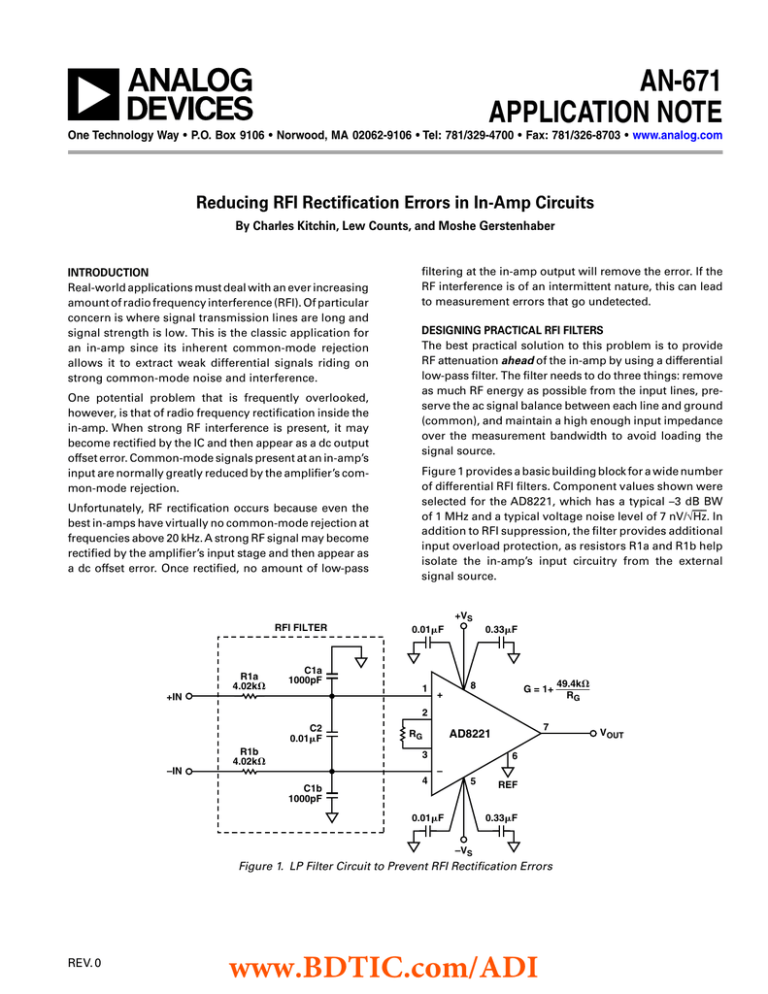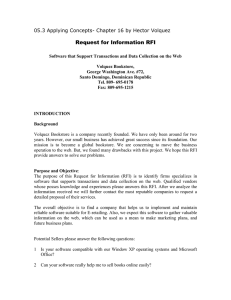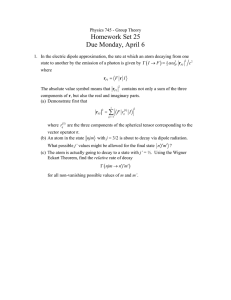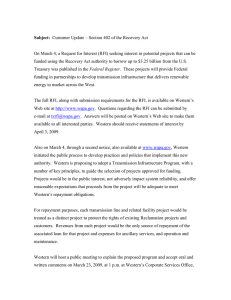
AN-671
APPLICATION NOTE
One Technology Way • P.O. Box 9106 • Norwood, MA 02062-9106 • Tel: 781/329-4700 • Fax: 781/326-8703 • www.analog.com
Reducing RFI Rectification Errors in In-Amp Circuits
By Charles Kitchin, Lew Counts, and Moshe Gerstenhaber
INTRODUCTION
Real-world applications must deal with an ever increasing
amount of radio frequency interference (RFI). Of particular
concern is where signal transmission lines are long and
signal strength is low. This is the classic application for
an in-amp since its inherent common-mode rejection
allows it to extract weak differential signals riding on
strong common-mode noise and interference.
One potential problem that is frequently overlooked,
however, is that of radio frequency rectification inside the
in-amp. When strong RF interference is present, it may
become rectified by the IC and then appear as a dc output
offset error. Common-mode signals present at an in-amp’s
input are normally greatly reduced by the amplifier’s common-mode rejection.
Unfortunately, RF rectification occurs because even the
best in-amps have virtually no common-mode rejection at
frequencies above 20 kHz. A strong RF signal may become
rectified by the amplifier’s input stage and then appear as
a dc offset error. Once rectified, no amount of low-pass
RFI FILTER
+IN
R1a
4.02k
C1a
1000pF
filtering at the in-amp output will remove the error. If the
RF interference is of an intermittent nature, this can lead
to measurement errors that go undetected.
DESIGNING PRACTICAL RFI FILTERS
The best practical solution to this problem is to provide
RF attenuation ahead of the in-amp by using a differential
low-pass filter. The filter needs to do three things: remove
as much RF energy as possible from the input lines, preserve the ac signal balance between each line and ground
(common), and maintain a high enough input impedance
over the measurement bandwidth to avoid loading the
signal source.
Figure 1 provides a basic building block for a wide number
of differential RFI filters. Component values shown were
selected for the AD8221, which has a typical –3 dB BW
of 1 MHz and a typical voltage noise level of 7 nV/÷Hz. In
addition to RFI suppression, the filter provides additional
input overload protection, as resistors R1a and R1b help
isolate the in-amp’s input circuitry from the external
signal source.
0.01F
1
+
+VS
0.33F
8
G = 1+
49.4k
RG
2
C2
0.01F
–IN
R1b
4.02k
3
C1b
1000pF
4
7
AD8221
RG
6
–
5
0.01F
REF
0.33F
–VS
Figure 1. LP Filter Circuit to Prevent RFI Rectification Errors
REV. 0
www.BDTIC.com/ADI
VOUT
AN-671
Figure 2 is a simplified version of the RFI circuit. It reveals
that the filter forms a bridge circuit whose output appears
across the in-amp’s input pins. Because of this, any mismatch between the time constants of C1a/R1a and C1b/R1b
will unbalance the bridge and reduce high frequency common-mode rejection. Therefore, resistors R1a and R1b and
capacitors C1a and C1b should always be equal.
The common-mode bandwidth defines what a commonmode RF signal sees between the two inputs tied together
and ground. It’s important to realize that C2 does not affect
the BW of the common-mode RF signal, as this capacitor is
connected between the two inputs (helping to keep them
at the same RF signal level). Therefore, common-mode BW
is set by the parallel impedance of the two RC networks
(R1a/C1a and R1b/C1b) to ground.
As shown, C2 is connected across the bridge output so that
C2 is effectively in parallel with the series combination of
C1a and C1b. Thus connected, C2 very effectively reduces
any ac CMR errors due to mismatching. For example, if
C2 is made ten times larger than C1, this provides a 20
reduction in CMR errors due to C1a/C1b mismatch. Note
that the filter does not affect dc CMR.
The –3 dB common-mode bandwidth is equal to
BWCM =
Using the circuit of Figure 1, with a C2 value of 0.01 F as
shown, the –3 dB differential signal BW is approximately
1900 Hz. When operating at a gain of 5, the circuit’s measured dc offset shift over a frequency range of 10 Hz to
20 MHz was less than 6 V RTI. At unity gain, there was
no measurable dc offset shift.
The RFI filter has two different bandwidths: differential and
common-mode. The differential BW defines the frequency
response of the filter with a differential input signal applied between the circuit’s two inputs, +IN and –IN. This
RC time constant is established by the sum of the two
equal-value input resistors (R1a, R1b) together with the
differential capacitance, which is C2 in parallel with the
series combination of C1a and C1b.
The RFI filter should be built using a PC board with ground
planes on both sides. All component leads should be made
as short as possible. Resistors R1 and R2 can be common
1% metal film units. However, all three capacitors need
to be reasonably high Q, low loss components. Capacitors C1a and C1b need to be 5% tolerance devices to
avoid degrading the circuit’s common-mode rejection.
The traditional 5% silver micas, miniature size micas, or
the new Panasonic 2% PPS film capacitors (Digi-key part
# PS1H102G-ND) are recommended.
The –3 dB differential bandwidth of this filter is equal to
BWDIFF =
1
2πR(2C 2 + C1)
R1a
1
2πR1C1
C1a
+IN
IN-AMP
C2
VOUT
–IN
R1b
C1b
Figure 2. Capacitor C2 Shunts C1a/C1b and Very Effectively Reduces AC CMR Errors Due to Component Mismatching
www.BDTIC.com/ADI
–2–
REV. 0
AN-671
SELECTING RFI INPUT FILTER COMPONENT VALUES USING
A COOKBOOK APPROACH.
The following general rules will greatly ease the design
of an RC input filter.
SPECIFIC DESIGN EXAMPLES
1. An RFI Circuit for AD620 Series In-Amps
Figure 3 is a circuit for general-purpose in-amps such
as the AD620 series, which have higher noise levels
(12 nV/÷Hz) and lower bandwidths than the AD8221.
Accordingly, the same input resistors were used, but
capacitor C2 was increased approximately five times, to
0.047 F, to provide adequate RF attenuation. With the
values shown, the circuit’s –3 dB BW is approximately
400 Hz; the bandwidth may be increased to 760 Hz by
reducing the resistance of R1 and R2 down to 2.2 k.
Note that this increased BW does not come free. It requires
the circuitry preceding the in-amp to drive a lower impedance load and results in somewhat less input overload
protection.
1. First, decide on the value of the two series resistors,
while ensuring that the previous circuitry can adequately
drive this impedance. With typical values between 2 k
and 10 k, these resistors should not contribute more
noise than that of the in-amp itself. Using a pair of
2 k resistors will add a Johnson noise of 8 nV/÷Hz;
this increases to 11 nV/÷Hz with 4 k resistors and to
18 nV/÷Hz with 10 k resistors.
2. Next, select an appropriate value for capacitor C2, which
sets the filter’s differential (signal) bandwidth. It’s always
best to set this as low as possible without attenuating
the input signal. A differential BW of 10 times the highest signal frequency is usually adequate.
2. An RFI Circuit for Micropower In-Amps
Some in-amps are more prone to RF rectification than others
and may need a more robust filter. A micropower in-amp,
such as the AD627, with its low input stage operating current is a good example. The simple expedient of increasing
the value of the two input resistors, R1a/R1b, and/or that
of capacitor C2, will provide further RF attenuation, at the
expense of a reduced signal bandwidth.
3. Then select values for capacitors C1a and C1b, which
set the common-mode bandwidth. For decent ac CMR,
these should be 10% the value of C2 or less. The common-mode bandwidth should always be less than 10%
of the in-amp’s bandwidth at unity gain.
RFI FILTER
+IN
R1a
4.02k
0.01F
C1a
1000pF
3
+
+VS
0.33F
7
1
C2
0.047F
–IN
R1b
4.02k
8
2
C1b
1000pF
6
AD620
RG
5
–
4
0.01F
REF
0.33F
–VS
Figure 3. RFI Circuit for AD620 Series In-Amps
REV. 0
www.BDTIC.com/ADI
–3–
VOUT
AN-671
3. An RFI Filter for the AD623 In-Amp
Figure 5 shows the recommended RFI circuit for use with
the AD623 in-amp. As this device is less prone to RFI than
the AD627, the input resistors can be reduced in value
from 20 k to 10 k; this increases the circuit’s signal
bandwidth and lowers the resistors’ noise contribution.
Moreover, the 10 k resistors still provide very effective
input protection. With the values shown, the bandwidth of
this filter is approximately 400 Hz. Operating at a gain of
100, the maximum dc offset shift, with a 1 V p-p input, is
less than 1 V RTI. At the same gain, the circuit’s RF signal
rejection is better than 74 dB.
Since the AD627 in-amp has higher noise (38 nV/÷Hz)
than general-purpose ICs like the AD620 series devices,
higher value input resistors can be used without seriously
degrading the circuit’s noise performance. The basic RC
RFI circuit of Figure 1 was modified to include higher value
input resistors and is shown in Figure 4.
The filter bandwidth is approximately 200 Hz. At a gain
of 100, the maximum dc offset shift with a 1 V p-p input
applied is approximately 400 V RTI over an input range
of 1 Hz to 20 MHz. At the same gain, the circuit’s RF signal
rejection (RF level at output/RF applied to the input) will
be better than 61 dB.
RFI FILTER
+IN
20k
0.01F
C1a
1000pF
3
+
+VS
0.33F
7
1
C2
0.022F
–IN
6
AD627
RG
8
20k
2
C1b
1000pF
VOUT
5
–
4
REF
0.33F
0.01F
–VS
Figure 4. RFI Suppression Circuit for the AD627
RFI FILTER
+IN
10k
0.01F
C1a
1000pF
3
+
+VS
0.33F
7
1
C2
0.022F
–IN
6
AD623
RG
8
10k
2
C1b
1000pF
VOUT
5
–
4
0.01F
REF
0.33F
–VS
Figure 5. AD623 RFI Suppression Circuit
www.BDTIC.com/ADI
–4–
REV. 0
AN-671
4. AD8225 RFI Filter Circuit
Figure 6 shows the recommended RFI filter for this in-amp.
The AD8225 in-amp has a fixed gain of 5 and a bit more
susceptibility to RFI than the AD8221. Without the RFI
filter, with a 2 V p-p, 10 Hz to 19 MHz sine wave applied,
this in-amp measures about 16 mV RTI of dc offset. The
filter used provides a heavier RF attenuation than that of
the AD8221 circuit by using larger resistor values: 10 k
instead of 4 k.This is permissible because of the AD8225’s
higher noise level. Using the filter, there was no measurable dc offset error.
RFI FILTER
+IN
10k
0.01F
C1a
1000pF
2
+
C2
0.01F
–IN
+VS
0.33F
7
6
AD8225
5
10k
3
C1b
1000pF
–
4
0.01F
REF
0.33F
–VS
Figure 6. AD8225 RFI Filter Circuit
REV. 0
www.BDTIC.com/ADI
–5–
VOUT
AN-671
applied to the input, the circuit of Figure 7 reduces the
dc offset shift to less than 4.5 V RTI. The high frequency
common-mode rejection ratio was also greatly reduced,
as shown by Table I.
5. Using Common Mode RF Chokes for In-Amp RFI Filters
As an alternative to using an RC input filter, a commercial
common-mode RF choke may be connected in front of
an in-amp as shown in Figure 7. A common-mode choke
is a two-winding RF choke using a common core. Any RF
signals that are common to both inputs will be attenuated by the choke. The common-mode choke provides
a simple means for reducing RFI with a minimum of
components and provides a greater signal pass band,
but the effectiveness of this method depends on the
quality of the particular common-mode choke being
used. A choke with good internal matching is preferred.
Another potential problem with using the choke is that
there is no increase in input protection as is provided by
the RC RFI filters.
Table I. AC CMR vs. Frequency,
Using the Circuit of Figure 7.
Frequency
CMRR
100 kHz
333 kHz
350 kHz
500 kHz
1 MHz
100 dB
83 dB
79 dB
88 dB
96 dB
Because some in-amps are more susceptible to RFI than
others, the use of a common-mode choke may sometimes
prove inadequate. In these cases, an RC input filter is a
better choice.
Using an AD620 in-amp with the RF choke specified, at
a gain of 1000, and a 1 V p-p common-mode sine wave
0.01F
+VS
0.33F
PULSE
ENGINEERING
#B4001 COMMON-MODE
RF CHOKE
+
+IN
RG
VOUT
IN-AMP
–
–IN
REF
0.01F
0.33F
–VS
Figure 7. Using a Commercial Common-Mode RF Choke for RFI Suppression
www.BDTIC.com/ADI
–6–
REV. 0
AN-671
6. RFI Testing
Figure 8 shows a typical setup for measuring RFI rejection.
To test these circuits for RFI suppression, connect the two
input terminals together using very short leads. Connect
a good quality sine wave generator to this input via a 50
terminated cable.
For measuring high frequency CMR, use an oscilloscope
connected to the in-amp output by a compensated scope
probe, and measure the peak-to-peak output voltage (i.e.,
feedthrough) versus input frequency. When calculating
CMRR versus frequency, remember to take into account
the input termination (VIN/2) and the gain of the in-amp.
Using an oscilloscope, adjust the generator for a 1 V p-p
output at the generator end of the cable. Set the in-amp to
operate at high gain (such as a gain of 100). DC offset shift
is simply read directly at the in-amp’s output using a DVM.
VIN
2
CMRR = 20 log
VOUT
Gain
0.01F
+VS
0.33F
RF
SIGNAL
GENERATOR
+
RFI
INPUT
FILTER
TERMINATION
RESISTOR
(50 OR 75 TYPICAL)
VOUT TO
SCOPE OR DVM
IN-AMP
RG
–
REF
0.01F
0.33F
–VS
Figure 8. Typical Test Setup for Measuring an In-Amp’s RFI Rejection
REV. 0
www.BDTIC.com/ADI
–7–
E04347–0–8/03(0)
www.BDTIC.com/ADI
© 2003 Analog Devices, Inc. All rights reserved. Trademarks and registered trademarks are the property of their respective companies.
–8–







